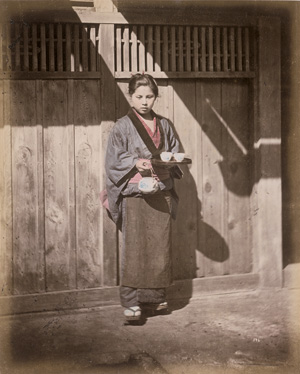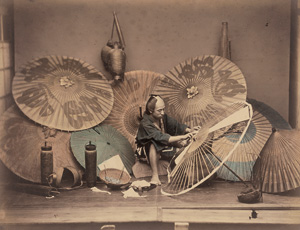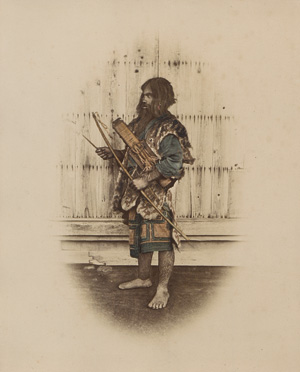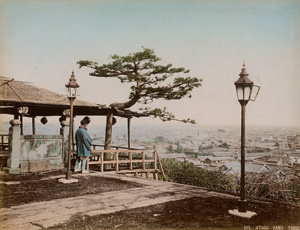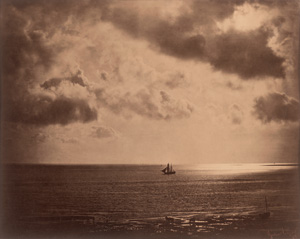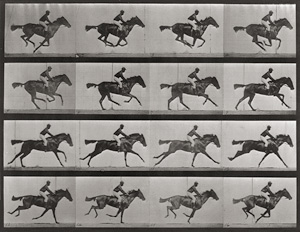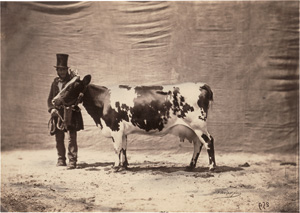Japan
Landscapes, temples and villages of Japan
Los 4046
Ergebnis (inkl. Aufgeld) *
1.500€ (US$ 1,705)
Photographer: Baron Raimund Stillfried-Ratenicz (1839-1911), Felice Beato (1832-1909), Kusakabe Kimbei (1841-1932) and unknown. Landscapes, temples and villages of Japan. 1860s-90s. 26 hand-colored albumen prints. Each circa 22 x 29 cm. Some with number and title in lower corners in the negative, most mounted to board and mounted in mats.
In good to very good condition.
Lit.: Claudia Gabriele Philippe/Dietmar Siegert/ Rainer Wick (eds.). Felice Beato in Japan. Photographien zum Ende der Feudalzeit 1863-1873. Heidelberg 1991, ill. pp. 45,108 and 178.
Photographer: Baron Raimund Stillfried-Ratenicz (1839-1911), Felice Beato (1832-1909) and unknown. Japanese portraits. 1870s-90s. 22 hand-colored albumen prints. Each circa 24 x 20 cm and reverse. Some with number and title in lower corners in the negative, most mounted to board and mounted in mats.
This attractive group includes portraits of farmers, teachers, Kendo fighters, geishas and musicians. – Several faded, especially in edges, some with light scuff/handling marks, some with light spots, otherwise most in good condition.
Lit.: Luke Gartlan. A Career of Japan. Baron Raimund von Stillfried and Early Yokohama Photography. Leiden/Boston 2016, ill. p. 201.
Claudia Gabriele Philippe/Dietmar Siegert/ Rainer Wick (eds.). Felice Beato in Japan. Photographien zum Ende der Feudalzeit 1863-1873. Heidelberg 1991, ill. p. 151, 168 and 170.
Photographers: Felice Beato (1832-1909), Baron Raimund von Stillfried (1839-1911), or Adolfo Farsari (1841-1898). Trades of Japan. 1870s. 3 albumen prints matted and mounted in wooden frame. Each ca. 20 x 26 cm (42 x 52 cm). One numbered in negative in lower left margin.
These photographs show traditional Japanese artisans and street vendors from the Meiji era, engaged in their crafts such as umbrella-making, basket-weaving, and selling household items. The detailed composition and focus on daily life make these images a classic example of the Yokohama school style, popular among Western collectors at the time. – A few light scuff marks, otherwise in excellent condition.
Lit.: Wieczorek, Alfried, and Claude W. Sui. Ins Land der Kirschblüte: Japanische Reisefotografie aus dem 19. Jahrhundert. Berlin: Kehrer Verlag, 2011, ill. p. 138.
Photographer: Baron Raimund Stillfried-Ratenicz (1839-1911), Felice Beato (1832-1909) and unknown. Ainu villages, Hokkaido and group portraits. 1880s. 7 (some hand-colored) albumen prints. Each circa 20 x 24 cm and reverse. Some with number and title in lower corners in the negative, most mounted to board and mounted in mats.
The indigenous Ainu people originally inhabited the main Japanese island of Honshu before being gradually pushed further north. They lived as hunters, gatherers, and fishers, cultivating a unique and independent culture. By the late 19th century, the Ainu faced increasing assimilation due to political pressure from the Meiji government. Today, only a small number of Ainu remain on the Japanese island of Hokkaido, the Kuril Islands, and Sakhalin. After enduring a long history of discrimination, their language, religion, and culture were officially recognized by the Japanese government in 2008. Historical records of Ainu culture are now rare, making this collection particularly significant. Of special interest are the photographs of their small settlements and group portraits depicting them in traditional clothing. – A few prints with isolated spots, otherwise in good to very good condition.
Lit.: Luke Gartlan. A Career of Japan. Baron Raimund von Stillfried and Early Yokohama Photography. Leiden/Boston 2016, ill. p.138.
Photographers: Kozaburo Tamamura (1856-1923) and Kusakabe Kimbei (1841-1934). Views of Tokyo. 1890s. 49 hand-colored albumen prints mounted to gilt-edged album boards. Each circa 20 x 26 cm (26 x 33 cm). Most with number and title in lower edge in the negative. Bound in black and gold silk album with chord binding (edges slightly worn).
This album features views of Mount Atago, Tokyo Imperial Palace, Prince Hotta’s Garden, Mukojima Garden, Shiba Toshogu Shrine, Kameido Tenjin Shrine, Sengaku Temple, Ueno and Asakusa, along with a two-part panoramic view of Tokyo (with some emulsion loss at the lower edge). – Some prints buckled through mounting, a few with some wear/spots, otherwise most in good to very good condition.
Le Gray, Gustave
Brig on the Water (Brick au Claire de Lune)
Los 4053
Ergebnis (inkl. Aufgeld) *
15.000€ (US$ 17,045)
Brig on the Water (Brick au Claire de Lune). 1856. Albumen print. 31,5 x 40,5 cm. Photographer's red signature stamp in lower right, mounted to board, matted and framed under museum glass in wooden frame.
Gustave Le Gray’s first exhibited seascape, Brig on the Water, is a seminal piece within his photographic career and was shown at a private meeting of the Photographic Society of London in November 1856, as well as several other venues that year and the following year. This image is considered one of his major masterpieces. The photograph’s striking composition, featuring a solitary ship against the sea and expansive sky, captivated viewers and critics alike, earning widespread acclaim for its technical mastery in capturing light and atmosphere. It quickly became a sensation across Europe, with 800 prints ordered within two months of its release, as noted in a London printseller’s advertisement in The Times in November 1856. Le Gray's albumen prints, often toned with a gold chloride solution, as the print offered here, display a rich violet-purple hue that has contributed to their enduring beauty. Today, prints of this iconic image are housed in major collections worldwide, including the Musée d’Orsay, the Metropolitan Museum of Art, the Princeton University Art Museum, the National Gallery of Art in Washington, the Nelson-Atkins Museum, the Portland Museum of Art, and the Victoria and Albert Museum. – Some vertical surface scratches in upper right, a few small surface irregularities, more visible in raking light, otherwise a strong, tonal print in very good condition.
Lit.: Sylvie Aubenas. Gustave Le Gray, 1820-1884. Los Angeles: The J. Paul Getty Museum, 2002. ill. pl. 128, p. 108.
Ken Jacobson. The Lovely Sea-View: A Study of the Marine Photographs Published by Gustave Le Gray, 1856-1858. Petches Bridge, 2001. ill. title page, p. 8, and back cover.
Karen Hellman, ed. Real/Ideal: Photography in Mid-Nineteenth-Century France. Los Angeles: J. Paul Getty Museum, 2016. ill. pl. 118.
Gordon Baldwin (ed.). Looking at Photographs: A Guide to Technical Terms. Los Angeles: The J. Paul Getty Museum. ill. p. 6.
Leuzinger, Georges and Albert Frisch
Early views of Brazil and the Amazon
Los 4054 [*]
Ergebnis (inkl. Aufgeld) *
6.000€ (US$ 6,818)
Early views of Brazil and the Amazon. ca. 1865. 19 albumen prints mounted to board (slightly soiled, some foxing). Each ca. 19 x 23 cm or reverse (27 x 37) cm. Most numbered, titled and signed in negative on lower margin of print.
This selection of photographs by Albert Frisch and Georges Leuzinger represents some of the earliest photographic documentation of the Amazon region. In 1867, Frisch embarked on an expedition commissioned by Leuzinger’s studio in Rio de Janeiro, capturing images of indigenous peoples, natural landscapes, and scenes spanning from Manaus to the Peruvian border. Frisch’s use of photomontage and combination printing techniques adds a distinctive artistic quality to these photographs, while also serving as rare historical records of the Amazon. – Some light fading, scuff marks and/or small tears, otherwise in good to very good condition.
Siegestor, Munich. 1860. Albumen print mounted to board (some handling creases). 20,5 x 15 cm (39 x 30 cm). Photographer's studio stamp embossed in lower margin of mount; titled in lower margin, annotated by another hand in pencil on recto; typewritten description on label attached to verso.
Mey & Widmayer, established in Munich in 1838, initially focused on publishing and lithography before transitioning to photography in the course of the 1850s. The studio became renowned for its meticulous documentation of Munich's architectural and cultural heritage. In addition to their photographic output, Mey & Widmayer produced detailed maps and prints, significantly contributing to Munich's cultural landscape during the 19th century. – Some scuff marks and slight fading along edges of print, otherwise in very good condition.
Muybridge, Eadweard
Animal Locomotion. An Electrophotographic Investigation of Consecutive Phases of Animal Movements
Los 4058
Ergebnis (inkl. Aufgeld) *
16.250€ (US$ 18,466)
Animal Locomotion. An Electrophotographic Investigation of Consecutive Phases of Animal Movements. 1872-1885. Bound volume with a total of 21 collotypes on plates. Each circa 46 x 60 cm. Each with printed caption, number and Muybridge's copyright on plate. Title page with dedication by Muybridge to "Sir Fredk Leighton Baron P.R.A. with the homage of the author June 1889" and later dedication by Lord Leighton "To Linley Sambourne from an old friend. July 22, 1896" in pencil. Bound in half morocco, cloth-covered album (corners rubbed, some scratches) gilt morocco cover label "Animal Locomotion. By Eadweard Muybridge. 1872-1885. Plates. University of Pennsylvania". University of Pennsylvania, Philadelphia, 1887.
Grolier, Truthful Lens, 123. Parr/Badger, The Photobook I, 52. This album features an important collection of Eadweard Muybridge’s groundbreaking “instantaneous photography,” a self-developed technique that enabled high-precision stop-motion images using an early rapid-acting shutter. Initially focusing on horses, Muybridge expanded his repertoire to include athletes, birds, lions, and camels, famously capturing the first image of a galloping horse with all four hooves off the ground in 1872. By 1885, he had amassed over 20,000 photographic negatives, comprising 781 sequential photo plates taken from multiple cameras positioned at carefully planned locations and angles, each illustrating a subject in continuous motion.
Muybridge’s handwritten dedication on the title page to Frederic Leighton, one of Victorian England’s celebrated artists, underscores the influence of his movement studies on contemporary artists such as Thomas Eakins, Frederic Remington, Ernest Meissonier, Edgar Degas, and the French inventor Étienne-Jules Marey. Notably, Leighton passed away in 1896, the same year he gifted this particular copy to his “old friend,” the renowned Punch cartoonist Edward Linley Sambourne.
The complete eleven-part work Animal Locomotion contains 781 numbered plates. The accompanying Author’s Edition, offered here, featured a removable subscription leaf that allowed subscribers to choose their preferred plates, resulting in varied content across different sets. This copy includes plates 3, 133, 152, 174, 187, 214, 279, 289, 347, 408, 465, 471, 565, 616, 626, 647, 659, 710, 721, 739, and 755. The exceptionally fine collotypes were printed by the Photo-Gravure Company in New York.
– Edges of plates time-stained and with some moisture staining, images not affected, images very finely printed and in very good condition.
Cow of the Ayrshire Race. 1856. Varnished salted paper print mounted to board. 20,2 x 28,5 cm (30,5 x 47,3 cm). Photographer's signature stamp and negative number in the negative in lower right, titled "Kuh von der Ayrshire Race" in black ink below the image on the mount, numbered "M 86" in pencil, Établissement Bovin label embossed onto top left corner of the mount.
Adrien Tournachon, the younger brother of Gaspard-Félix Tournachon (better known as Nadar), briefly collaborated with his brother after opening a photographic studio. However, competitive tensions arose in 1855, leading to a court ruling that Félix, the more accomplished photographer, was “the only, the true Nadar,” preventing Adrien from using the name “Nadar jeune.” In 1856 and 1860, Adrien photographed prize-winning livestock at Paris agricultural fairs, utilizing the faster collodion wet plate process instead of the slower paper negatives previously used. At the 1856 fair, he successfully produced over 120 negatives, around 50 of which were printed and included in an album presented to the minister of agriculture and commerce. The photograph offered here is printed using the vernis-cuit technique, where the paper is coated with layers of gelatin and tannin to give it the appearance of varnished leather. – A few light surface scratches, slightly faded in areas, otherwise a rich dark print in very good condition.
[*]: Regelbesteuert gemäß Auktionsbedingungen. [^]: Ausgleich von Einfuhr-Umsatzsteuer.
* Alle Angaben inkl. 25% Regelaufgeld ohne MwSt. und ohne Gewähr – Irrtum vorbehalten.
Galerie Bassenge
Erdener Str. 5A
14193 Berlin
Öffnungszeiten:
Montag bis Donnerstag, 10–18 Uhr,
Freitag, 10–16 Uhr
Telefon: +49 30 8938029-0
Fax: +49 30 8918025
E-Mail: info (at) bassenge.com
Impressum
Datenschutzerklärung
© 2024 Galerie Gerda Bassenge
Galerie Bassenge
Erdener Str. 5A
14193 Berlin
Öffnungszeiten:
Montag bis Donnerstag, 10–18 Uhr,
Freitag, 10–16 Uhr
Telefon: +49 30 8938029-0
Fax: +49 30 8918025
E-Mail: info (at) bassenge.com
Impressum
Datenschutzerklärung
© 2022 Galerie Gerda Bassenge


